ACCY305 Assessment: Corporate Governance of the Commonwealth Bank
VerifiedAdded on 2022/09/12
|13
|2733
|11
Report
AI Summary
This report presents a comprehensive analysis of the corporate governance failures at the Commonwealth Bank of Australia (CBA). It begins with an abstract summarizing the case and introduces the concept of corporate governance, emphasizing the role of rules, regulations, and ethical practices in ensuring transparency and accountability. The discussion section delves into the principles of corporate governance, highlighting how CBA's actions, such as encouraging unethical behavior among financial planners and prioritizing sales targets over client interests, led to financial scandals and a damaged reputation. The report examines specific instances of unethical conduct, including the appointment of unqualified financial planners, the forging of customer documents, and the use of incentives to promote aggressive sales tactics. It explores the agency theory, conflict of interest, and contextual factors influencing ethical decision-making within the bank. The report concludes by emphasizing the importance of ethical leadership, transparency, and adherence to corporate governance principles, as outlined by the ASX Corporate Governance Council, to prevent financial misconduct and maintain stakeholder trust. The case study underscores the need for strong ethical environments and the adverse consequences of prioritizing profit over customer interests.
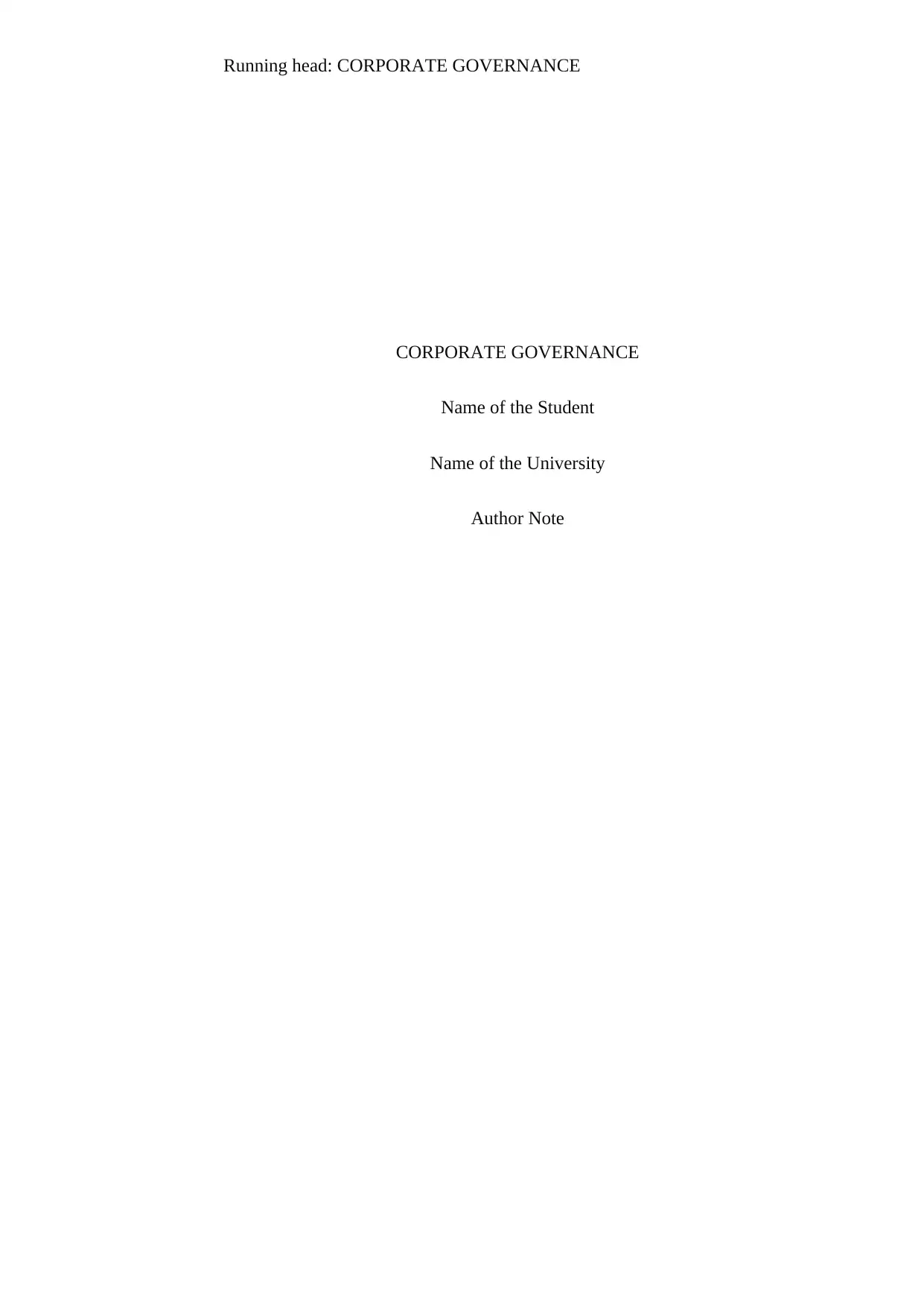
Running head: CORPORATE GOVERNANCE
CORPORATE GOVERNANCE
Name of the Student
Name of the University
Author Note
CORPORATE GOVERNANCE
Name of the Student
Name of the University
Author Note
Paraphrase This Document
Need a fresh take? Get an instant paraphrase of this document with our AI Paraphraser
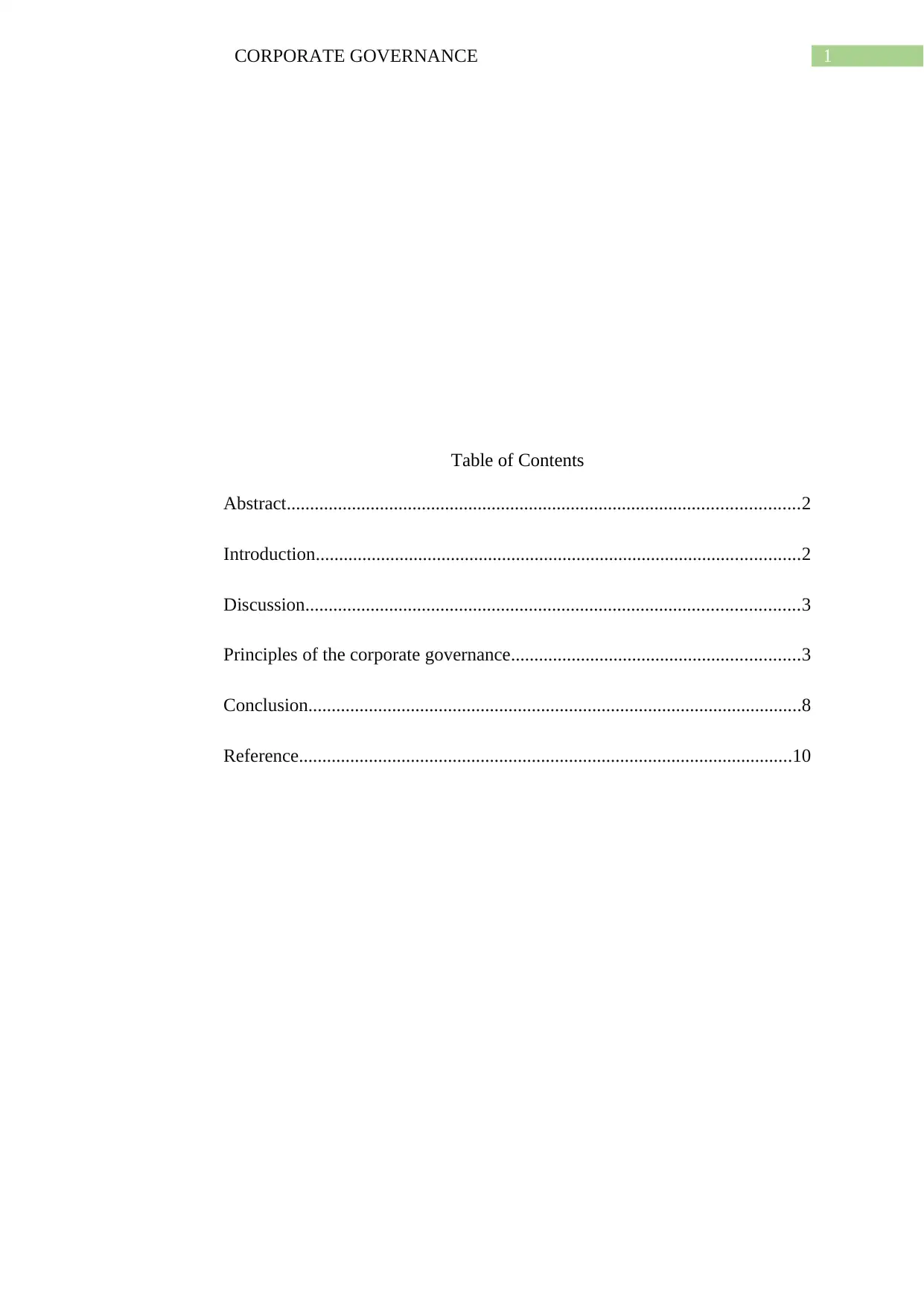
1CORPORATE GOVERNANCE
Table of Contents
Abstract..............................................................................................................2
Introduction........................................................................................................2
Discussion..........................................................................................................3
Principles of the corporate governance..............................................................3
Conclusion..........................................................................................................8
Reference..........................................................................................................10
Table of Contents
Abstract..............................................................................................................2
Introduction........................................................................................................2
Discussion..........................................................................................................3
Principles of the corporate governance..............................................................3
Conclusion..........................................................................................................8
Reference..........................................................................................................10
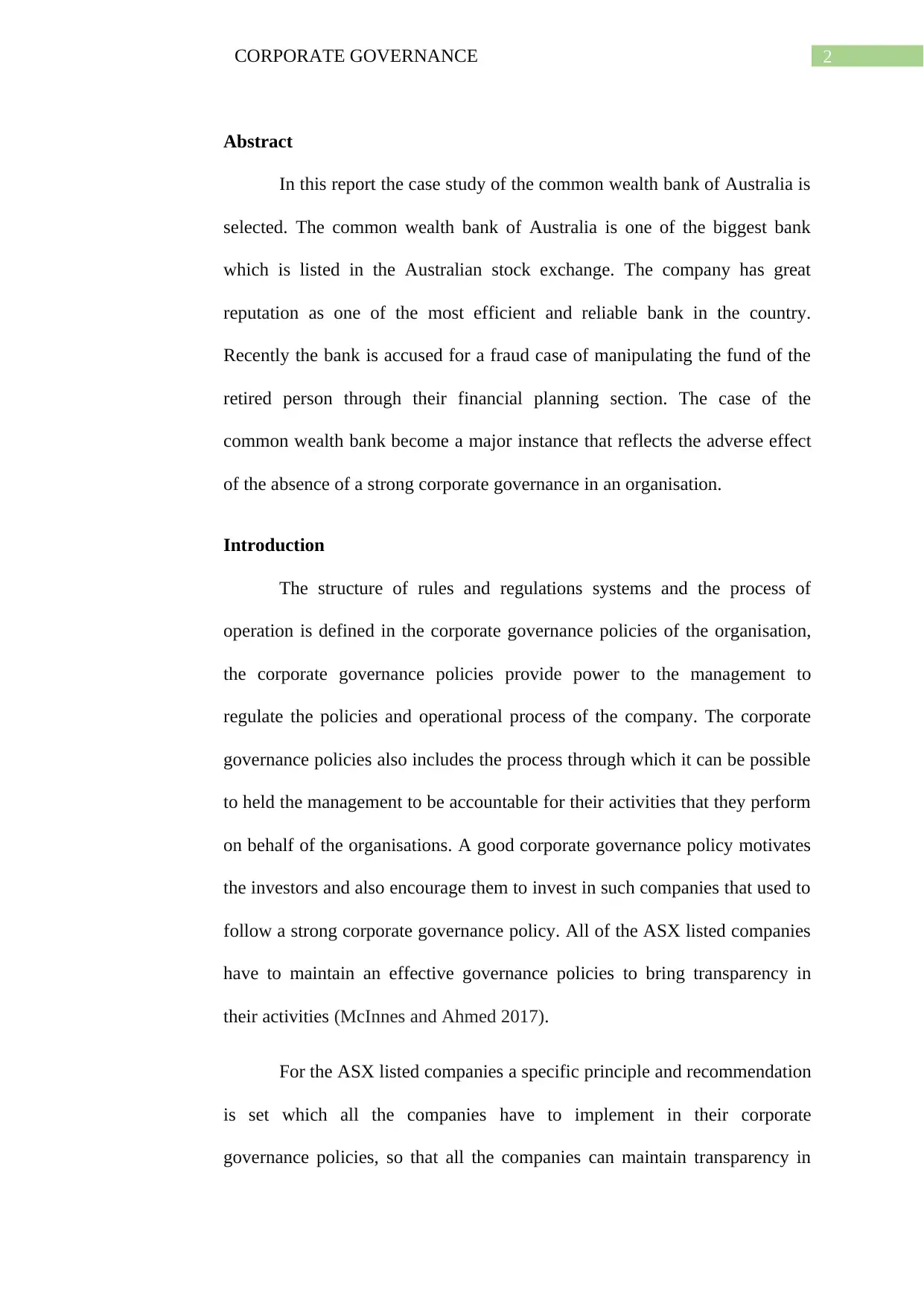
2CORPORATE GOVERNANCE
Abstract
In this report the case study of the common wealth bank of Australia is
selected. The common wealth bank of Australia is one of the biggest bank
which is listed in the Australian stock exchange. The company has great
reputation as one of the most efficient and reliable bank in the country.
Recently the bank is accused for a fraud case of manipulating the fund of the
retired person through their financial planning section. The case of the
common wealth bank become a major instance that reflects the adverse effect
of the absence of a strong corporate governance in an organisation.
Introduction
The structure of rules and regulations systems and the process of
operation is defined in the corporate governance policies of the organisation,
the corporate governance policies provide power to the management to
regulate the policies and operational process of the company. The corporate
governance policies also includes the process through which it can be possible
to held the management to be accountable for their activities that they perform
on behalf of the organisations. A good corporate governance policy motivates
the investors and also encourage them to invest in such companies that used to
follow a strong corporate governance policy. All of the ASX listed companies
have to maintain an effective governance policies to bring transparency in
their activities (McInnes and Ahmed 2017).
For the ASX listed companies a specific principle and recommendation
is set which all the companies have to implement in their corporate
governance policies, so that all the companies can maintain transparency in
Abstract
In this report the case study of the common wealth bank of Australia is
selected. The common wealth bank of Australia is one of the biggest bank
which is listed in the Australian stock exchange. The company has great
reputation as one of the most efficient and reliable bank in the country.
Recently the bank is accused for a fraud case of manipulating the fund of the
retired person through their financial planning section. The case of the
common wealth bank become a major instance that reflects the adverse effect
of the absence of a strong corporate governance in an organisation.
Introduction
The structure of rules and regulations systems and the process of
operation is defined in the corporate governance policies of the organisation,
the corporate governance policies provide power to the management to
regulate the policies and operational process of the company. The corporate
governance policies also includes the process through which it can be possible
to held the management to be accountable for their activities that they perform
on behalf of the organisations. A good corporate governance policy motivates
the investors and also encourage them to invest in such companies that used to
follow a strong corporate governance policy. All of the ASX listed companies
have to maintain an effective governance policies to bring transparency in
their activities (McInnes and Ahmed 2017).
For the ASX listed companies a specific principle and recommendation
is set which all the companies have to implement in their corporate
governance policies, so that all the companies can maintain transparency in
⊘ This is a preview!⊘
Do you want full access?
Subscribe today to unlock all pages.

Trusted by 1+ million students worldwide
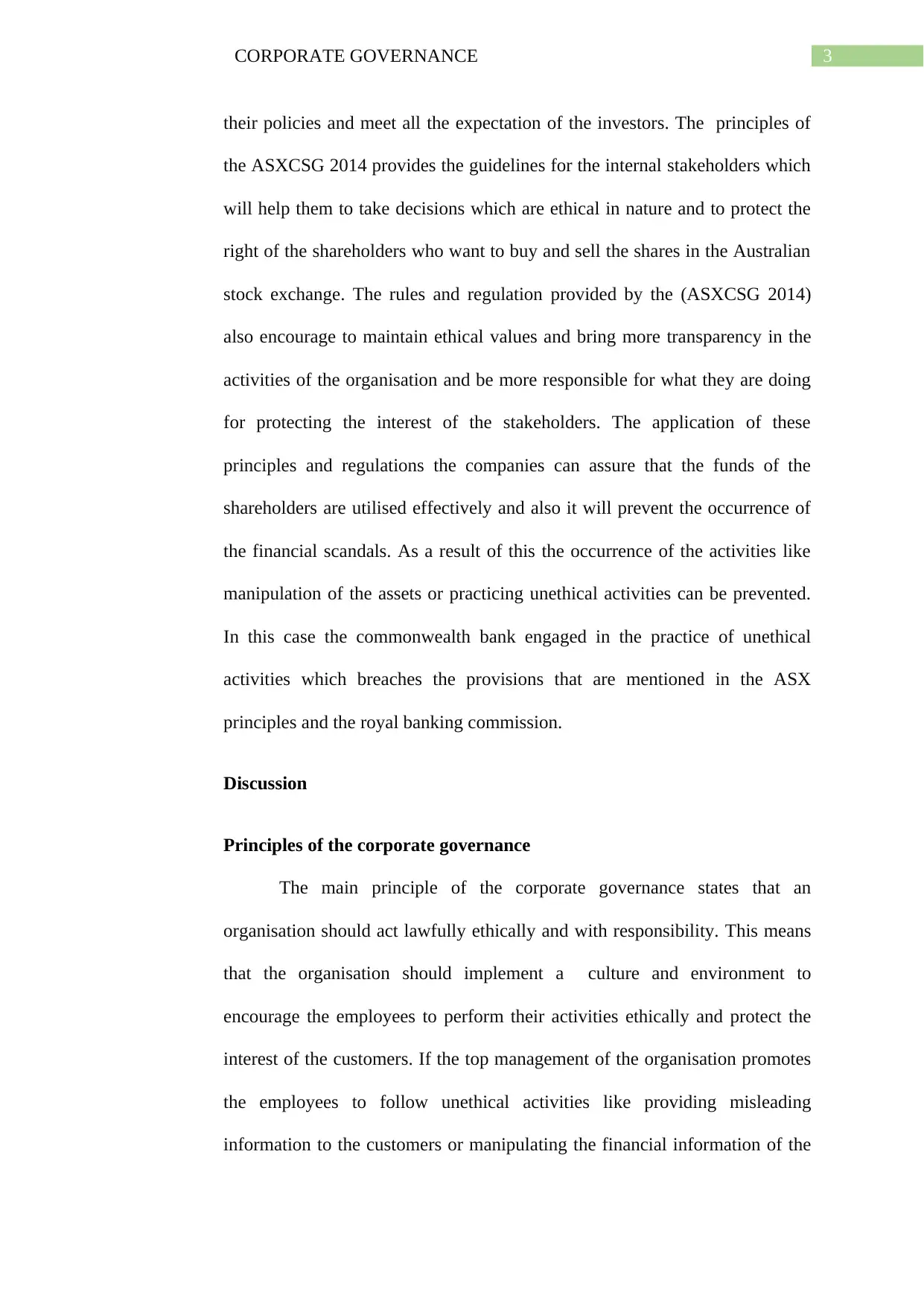
3CORPORATE GOVERNANCE
their policies and meet all the expectation of the investors. The principles of
the ASXCSG 2014 provides the guidelines for the internal stakeholders which
will help them to take decisions which are ethical in nature and to protect the
right of the shareholders who want to buy and sell the shares in the Australian
stock exchange. The rules and regulation provided by the (ASXCSG 2014)
also encourage to maintain ethical values and bring more transparency in the
activities of the organisation and be more responsible for what they are doing
for protecting the interest of the stakeholders. The application of these
principles and regulations the companies can assure that the funds of the
shareholders are utilised effectively and also it will prevent the occurrence of
the financial scandals. As a result of this the occurrence of the activities like
manipulation of the assets or practicing unethical activities can be prevented.
In this case the commonwealth bank engaged in the practice of unethical
activities which breaches the provisions that are mentioned in the ASX
principles and the royal banking commission.
Discussion
Principles of the corporate governance
The main principle of the corporate governance states that an
organisation should act lawfully ethically and with responsibility. This means
that the organisation should implement a culture and environment to
encourage the employees to perform their activities ethically and protect the
interest of the customers. If the top management of the organisation promotes
the employees to follow unethical activities like providing misleading
information to the customers or manipulating the financial information of the
their policies and meet all the expectation of the investors. The principles of
the ASXCSG 2014 provides the guidelines for the internal stakeholders which
will help them to take decisions which are ethical in nature and to protect the
right of the shareholders who want to buy and sell the shares in the Australian
stock exchange. The rules and regulation provided by the (ASXCSG 2014)
also encourage to maintain ethical values and bring more transparency in the
activities of the organisation and be more responsible for what they are doing
for protecting the interest of the stakeholders. The application of these
principles and regulations the companies can assure that the funds of the
shareholders are utilised effectively and also it will prevent the occurrence of
the financial scandals. As a result of this the occurrence of the activities like
manipulation of the assets or practicing unethical activities can be prevented.
In this case the commonwealth bank engaged in the practice of unethical
activities which breaches the provisions that are mentioned in the ASX
principles and the royal banking commission.
Discussion
Principles of the corporate governance
The main principle of the corporate governance states that an
organisation should act lawfully ethically and with responsibility. This means
that the organisation should implement a culture and environment to
encourage the employees to perform their activities ethically and protect the
interest of the customers. If the top management of the organisation promotes
the employees to follow unethical activities like providing misleading
information to the customers or manipulating the financial information of the
Paraphrase This Document
Need a fresh take? Get an instant paraphrase of this document with our AI Paraphraser
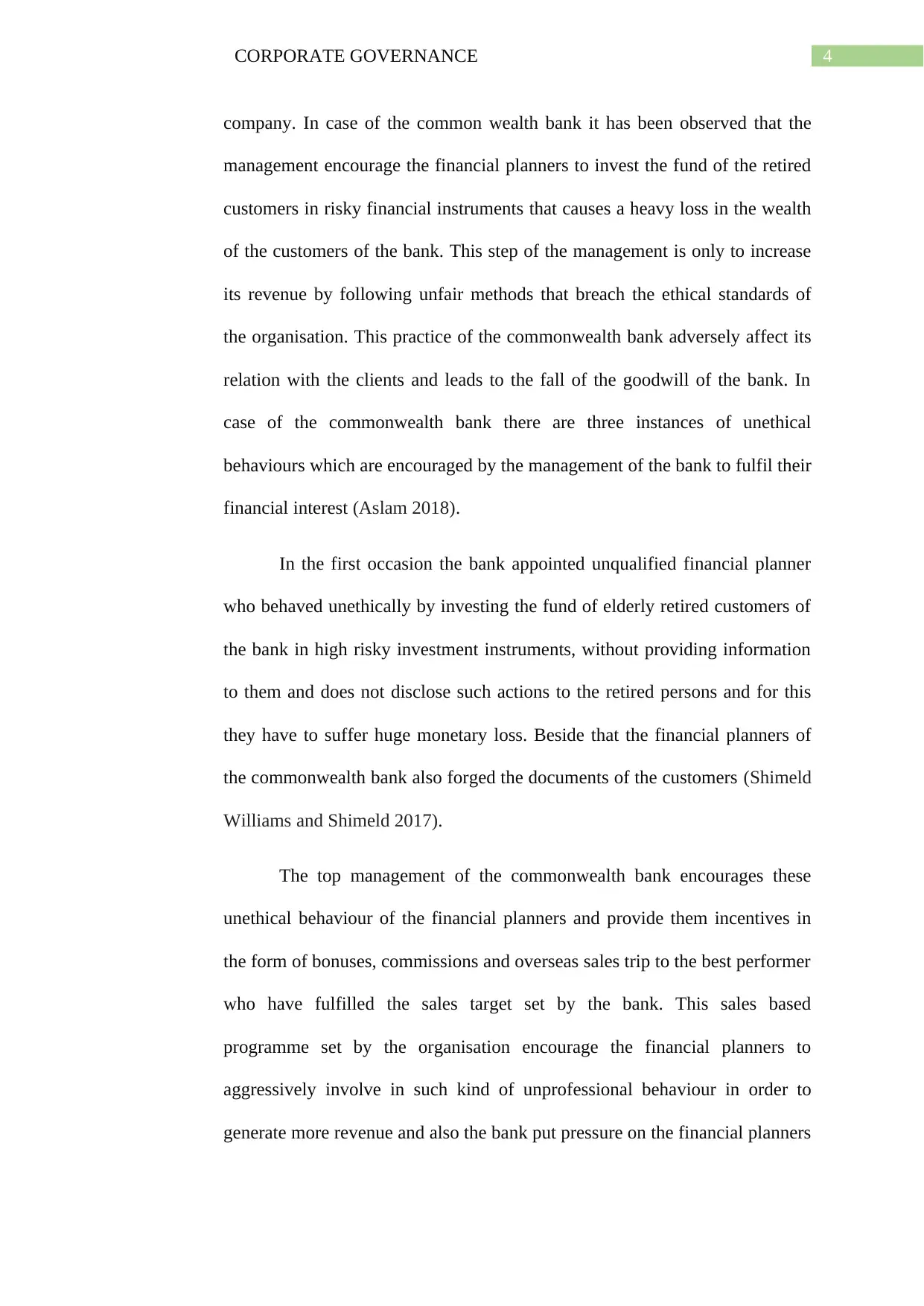
4CORPORATE GOVERNANCE
company. In case of the common wealth bank it has been observed that the
management encourage the financial planners to invest the fund of the retired
customers in risky financial instruments that causes a heavy loss in the wealth
of the customers of the bank. This step of the management is only to increase
its revenue by following unfair methods that breach the ethical standards of
the organisation. This practice of the commonwealth bank adversely affect its
relation with the clients and leads to the fall of the goodwill of the bank. In
case of the commonwealth bank there are three instances of unethical
behaviours which are encouraged by the management of the bank to fulfil their
financial interest (Aslam 2018).
In the first occasion the bank appointed unqualified financial planner
who behaved unethically by investing the fund of elderly retired customers of
the bank in high risky investment instruments, without providing information
to them and does not disclose such actions to the retired persons and for this
they have to suffer huge monetary loss. Beside that the financial planners of
the commonwealth bank also forged the documents of the customers (Shimeld
Williams and Shimeld 2017).
The top management of the commonwealth bank encourages these
unethical behaviour of the financial planners and provide them incentives in
the form of bonuses, commissions and overseas sales trip to the best performer
who have fulfilled the sales target set by the bank. This sales based
programme set by the organisation encourage the financial planners to
aggressively involve in such kind of unprofessional behaviour in order to
generate more revenue and also the bank put pressure on the financial planners
company. In case of the common wealth bank it has been observed that the
management encourage the financial planners to invest the fund of the retired
customers in risky financial instruments that causes a heavy loss in the wealth
of the customers of the bank. This step of the management is only to increase
its revenue by following unfair methods that breach the ethical standards of
the organisation. This practice of the commonwealth bank adversely affect its
relation with the clients and leads to the fall of the goodwill of the bank. In
case of the commonwealth bank there are three instances of unethical
behaviours which are encouraged by the management of the bank to fulfil their
financial interest (Aslam 2018).
In the first occasion the bank appointed unqualified financial planner
who behaved unethically by investing the fund of elderly retired customers of
the bank in high risky investment instruments, without providing information
to them and does not disclose such actions to the retired persons and for this
they have to suffer huge monetary loss. Beside that the financial planners of
the commonwealth bank also forged the documents of the customers (Shimeld
Williams and Shimeld 2017).
The top management of the commonwealth bank encourages these
unethical behaviour of the financial planners and provide them incentives in
the form of bonuses, commissions and overseas sales trip to the best performer
who have fulfilled the sales target set by the bank. This sales based
programme set by the organisation encourage the financial planners to
aggressively involve in such kind of unprofessional behaviour in order to
generate more revenue and also the bank put pressure on the financial planners
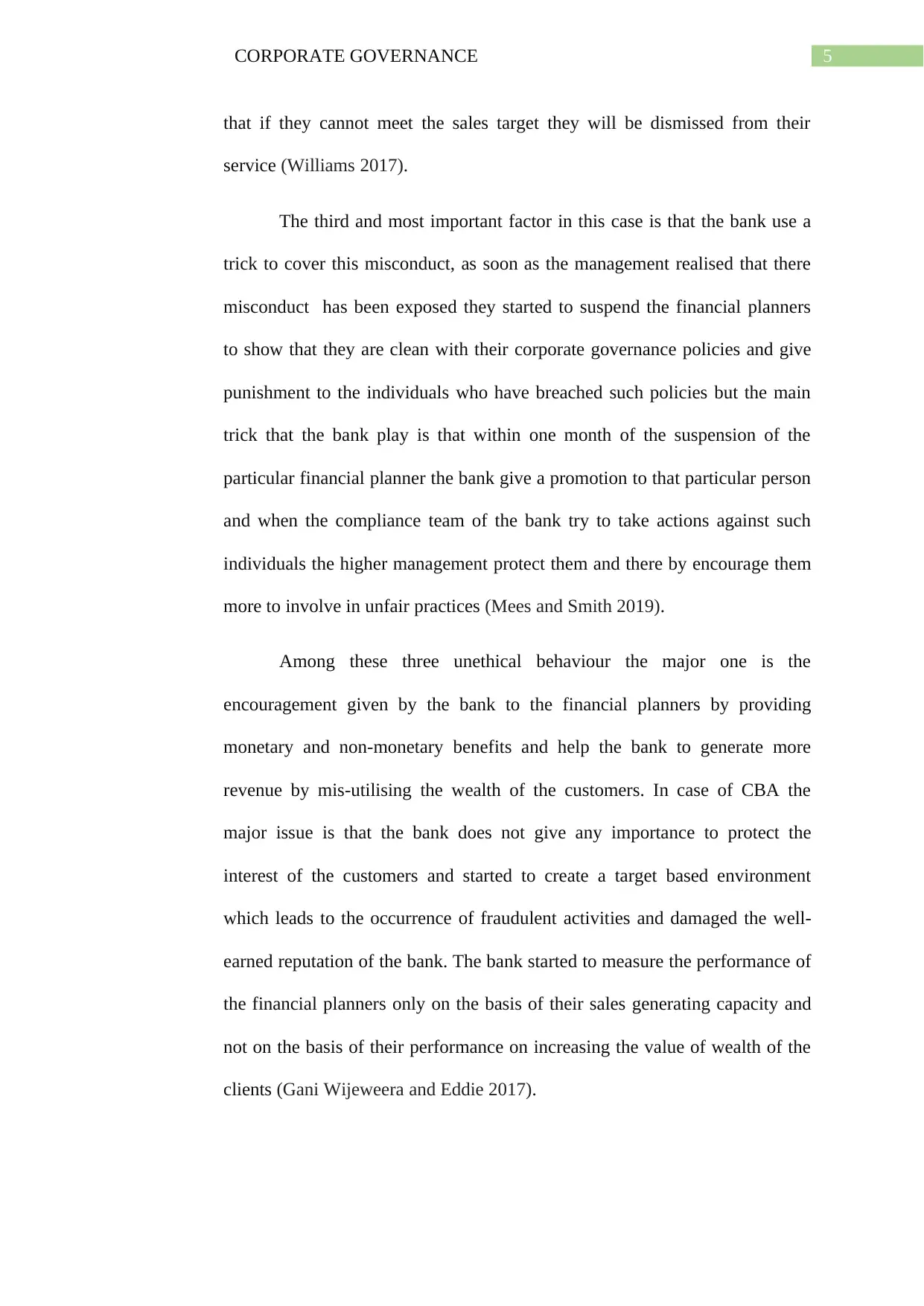
5CORPORATE GOVERNANCE
that if they cannot meet the sales target they will be dismissed from their
service (Williams 2017).
The third and most important factor in this case is that the bank use a
trick to cover this misconduct, as soon as the management realised that there
misconduct has been exposed they started to suspend the financial planners
to show that they are clean with their corporate governance policies and give
punishment to the individuals who have breached such policies but the main
trick that the bank play is that within one month of the suspension of the
particular financial planner the bank give a promotion to that particular person
and when the compliance team of the bank try to take actions against such
individuals the higher management protect them and there by encourage them
more to involve in unfair practices (Mees and Smith 2019).
Among these three unethical behaviour the major one is the
encouragement given by the bank to the financial planners by providing
monetary and non-monetary benefits and help the bank to generate more
revenue by mis-utilising the wealth of the customers. In case of CBA the
major issue is that the bank does not give any importance to protect the
interest of the customers and started to create a target based environment
which leads to the occurrence of fraudulent activities and damaged the well-
earned reputation of the bank. The bank started to measure the performance of
the financial planners only on the basis of their sales generating capacity and
not on the basis of their performance on increasing the value of wealth of the
clients (Gani Wijeweera and Eddie 2017).
that if they cannot meet the sales target they will be dismissed from their
service (Williams 2017).
The third and most important factor in this case is that the bank use a
trick to cover this misconduct, as soon as the management realised that there
misconduct has been exposed they started to suspend the financial planners
to show that they are clean with their corporate governance policies and give
punishment to the individuals who have breached such policies but the main
trick that the bank play is that within one month of the suspension of the
particular financial planner the bank give a promotion to that particular person
and when the compliance team of the bank try to take actions against such
individuals the higher management protect them and there by encourage them
more to involve in unfair practices (Mees and Smith 2019).
Among these three unethical behaviour the major one is the
encouragement given by the bank to the financial planners by providing
monetary and non-monetary benefits and help the bank to generate more
revenue by mis-utilising the wealth of the customers. In case of CBA the
major issue is that the bank does not give any importance to protect the
interest of the customers and started to create a target based environment
which leads to the occurrence of fraudulent activities and damaged the well-
earned reputation of the bank. The bank started to measure the performance of
the financial planners only on the basis of their sales generating capacity and
not on the basis of their performance on increasing the value of wealth of the
clients (Gani Wijeweera and Eddie 2017).
⊘ This is a preview!⊘
Do you want full access?
Subscribe today to unlock all pages.

Trusted by 1+ million students worldwide
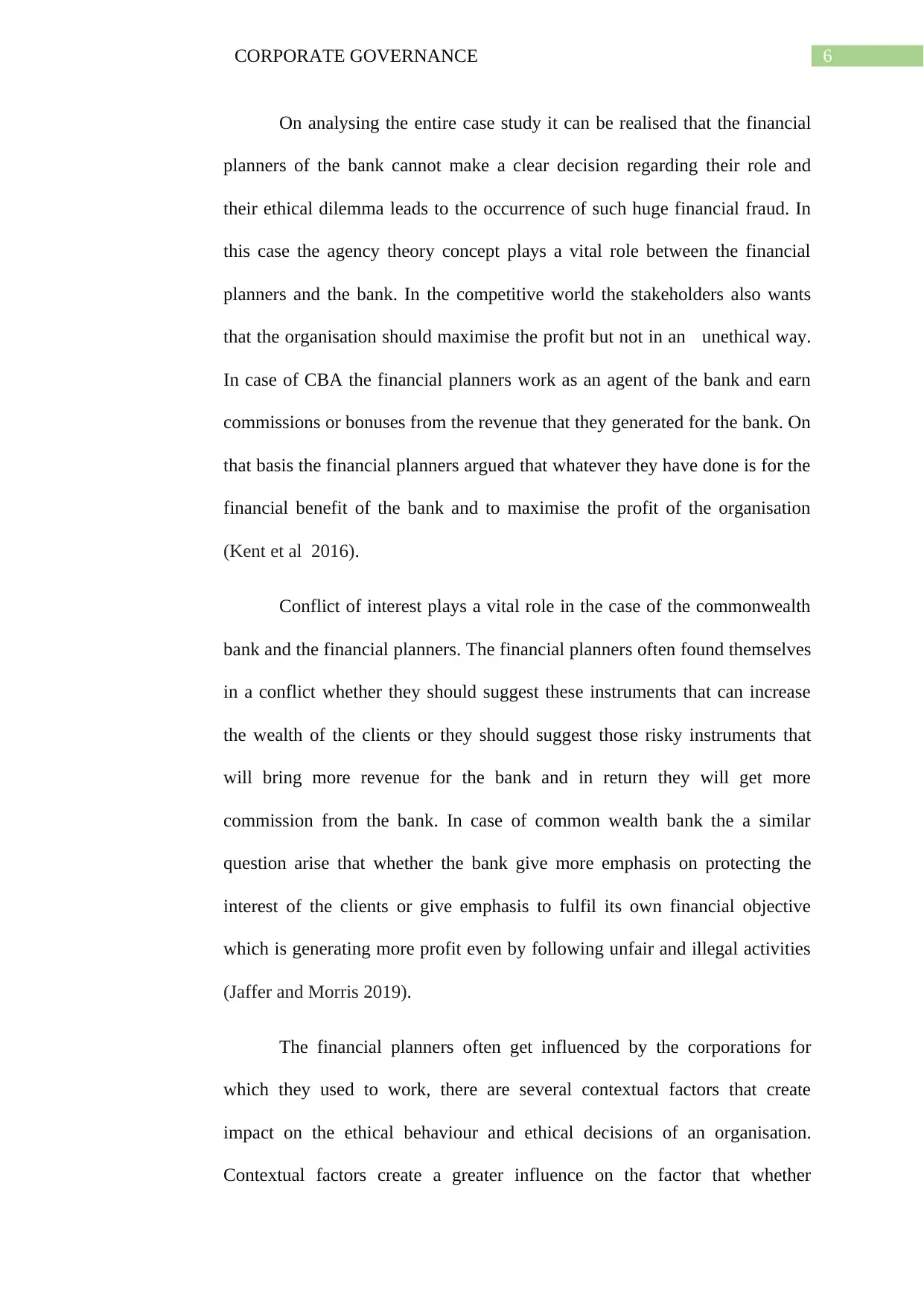
6CORPORATE GOVERNANCE
On analysing the entire case study it can be realised that the financial
planners of the bank cannot make a clear decision regarding their role and
their ethical dilemma leads to the occurrence of such huge financial fraud. In
this case the agency theory concept plays a vital role between the financial
planners and the bank. In the competitive world the stakeholders also wants
that the organisation should maximise the profit but not in an unethical way.
In case of CBA the financial planners work as an agent of the bank and earn
commissions or bonuses from the revenue that they generated for the bank. On
that basis the financial planners argued that whatever they have done is for the
financial benefit of the bank and to maximise the profit of the organisation
(Kent et al 2016).
Conflict of interest plays a vital role in the case of the commonwealth
bank and the financial planners. The financial planners often found themselves
in a conflict whether they should suggest these instruments that can increase
the wealth of the clients or they should suggest those risky instruments that
will bring more revenue for the bank and in return they will get more
commission from the bank. In case of common wealth bank the a similar
question arise that whether the bank give more emphasis on protecting the
interest of the clients or give emphasis to fulfil its own financial objective
which is generating more profit even by following unfair and illegal activities
(Jaffer and Morris 2019).
The financial planners often get influenced by the corporations for
which they used to work, there are several contextual factors that create
impact on the ethical behaviour and ethical decisions of an organisation.
Contextual factors create a greater influence on the factor that whether
On analysing the entire case study it can be realised that the financial
planners of the bank cannot make a clear decision regarding their role and
their ethical dilemma leads to the occurrence of such huge financial fraud. In
this case the agency theory concept plays a vital role between the financial
planners and the bank. In the competitive world the stakeholders also wants
that the organisation should maximise the profit but not in an unethical way.
In case of CBA the financial planners work as an agent of the bank and earn
commissions or bonuses from the revenue that they generated for the bank. On
that basis the financial planners argued that whatever they have done is for the
financial benefit of the bank and to maximise the profit of the organisation
(Kent et al 2016).
Conflict of interest plays a vital role in the case of the commonwealth
bank and the financial planners. The financial planners often found themselves
in a conflict whether they should suggest these instruments that can increase
the wealth of the clients or they should suggest those risky instruments that
will bring more revenue for the bank and in return they will get more
commission from the bank. In case of common wealth bank the a similar
question arise that whether the bank give more emphasis on protecting the
interest of the clients or give emphasis to fulfil its own financial objective
which is generating more profit even by following unfair and illegal activities
(Jaffer and Morris 2019).
The financial planners often get influenced by the corporations for
which they used to work, there are several contextual factors that create
impact on the ethical behaviour and ethical decisions of an organisation.
Contextual factors create a greater influence on the factor that whether
Paraphrase This Document
Need a fresh take? Get an instant paraphrase of this document with our AI Paraphraser
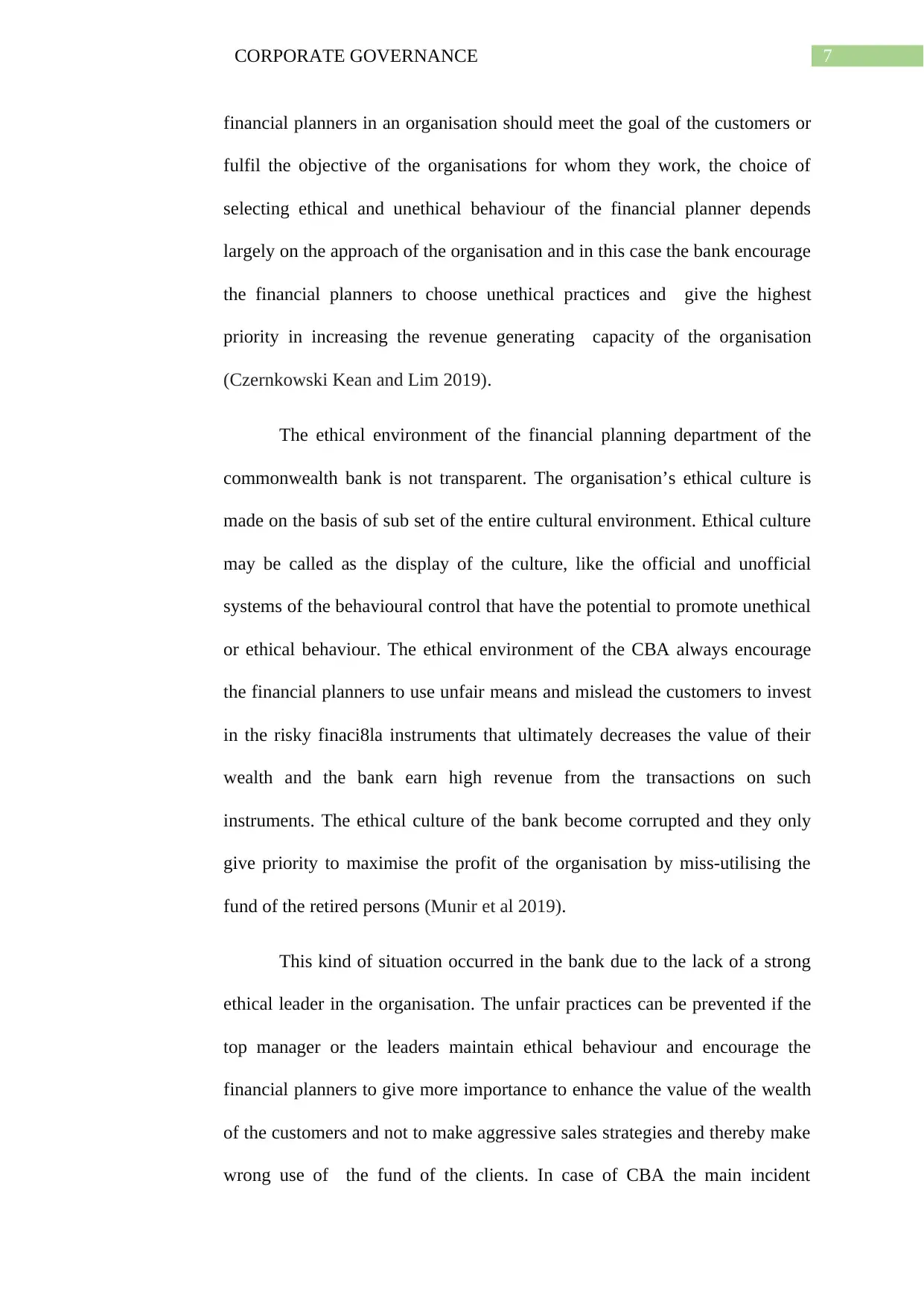
7CORPORATE GOVERNANCE
financial planners in an organisation should meet the goal of the customers or
fulfil the objective of the organisations for whom they work, the choice of
selecting ethical and unethical behaviour of the financial planner depends
largely on the approach of the organisation and in this case the bank encourage
the financial planners to choose unethical practices and give the highest
priority in increasing the revenue generating capacity of the organisation
(Czernkowski Kean and Lim 2019).
The ethical environment of the financial planning department of the
commonwealth bank is not transparent. The organisation’s ethical culture is
made on the basis of sub set of the entire cultural environment. Ethical culture
may be called as the display of the culture, like the official and unofficial
systems of the behavioural control that have the potential to promote unethical
or ethical behaviour. The ethical environment of the CBA always encourage
the financial planners to use unfair means and mislead the customers to invest
in the risky finaci8la instruments that ultimately decreases the value of their
wealth and the bank earn high revenue from the transactions on such
instruments. The ethical culture of the bank become corrupted and they only
give priority to maximise the profit of the organisation by miss-utilising the
fund of the retired persons (Munir et al 2019).
This kind of situation occurred in the bank due to the lack of a strong
ethical leader in the organisation. The unfair practices can be prevented if the
top manager or the leaders maintain ethical behaviour and encourage the
financial planners to give more importance to enhance the value of the wealth
of the customers and not to make aggressive sales strategies and thereby make
wrong use of the fund of the clients. In case of CBA the main incident
financial planners in an organisation should meet the goal of the customers or
fulfil the objective of the organisations for whom they work, the choice of
selecting ethical and unethical behaviour of the financial planner depends
largely on the approach of the organisation and in this case the bank encourage
the financial planners to choose unethical practices and give the highest
priority in increasing the revenue generating capacity of the organisation
(Czernkowski Kean and Lim 2019).
The ethical environment of the financial planning department of the
commonwealth bank is not transparent. The organisation’s ethical culture is
made on the basis of sub set of the entire cultural environment. Ethical culture
may be called as the display of the culture, like the official and unofficial
systems of the behavioural control that have the potential to promote unethical
or ethical behaviour. The ethical environment of the CBA always encourage
the financial planners to use unfair means and mislead the customers to invest
in the risky finaci8la instruments that ultimately decreases the value of their
wealth and the bank earn high revenue from the transactions on such
instruments. The ethical culture of the bank become corrupted and they only
give priority to maximise the profit of the organisation by miss-utilising the
fund of the retired persons (Munir et al 2019).
This kind of situation occurred in the bank due to the lack of a strong
ethical leader in the organisation. The unfair practices can be prevented if the
top manager or the leaders maintain ethical behaviour and encourage the
financial planners to give more importance to enhance the value of the wealth
of the customers and not to make aggressive sales strategies and thereby make
wrong use of the fund of the clients. In case of CBA the main incident
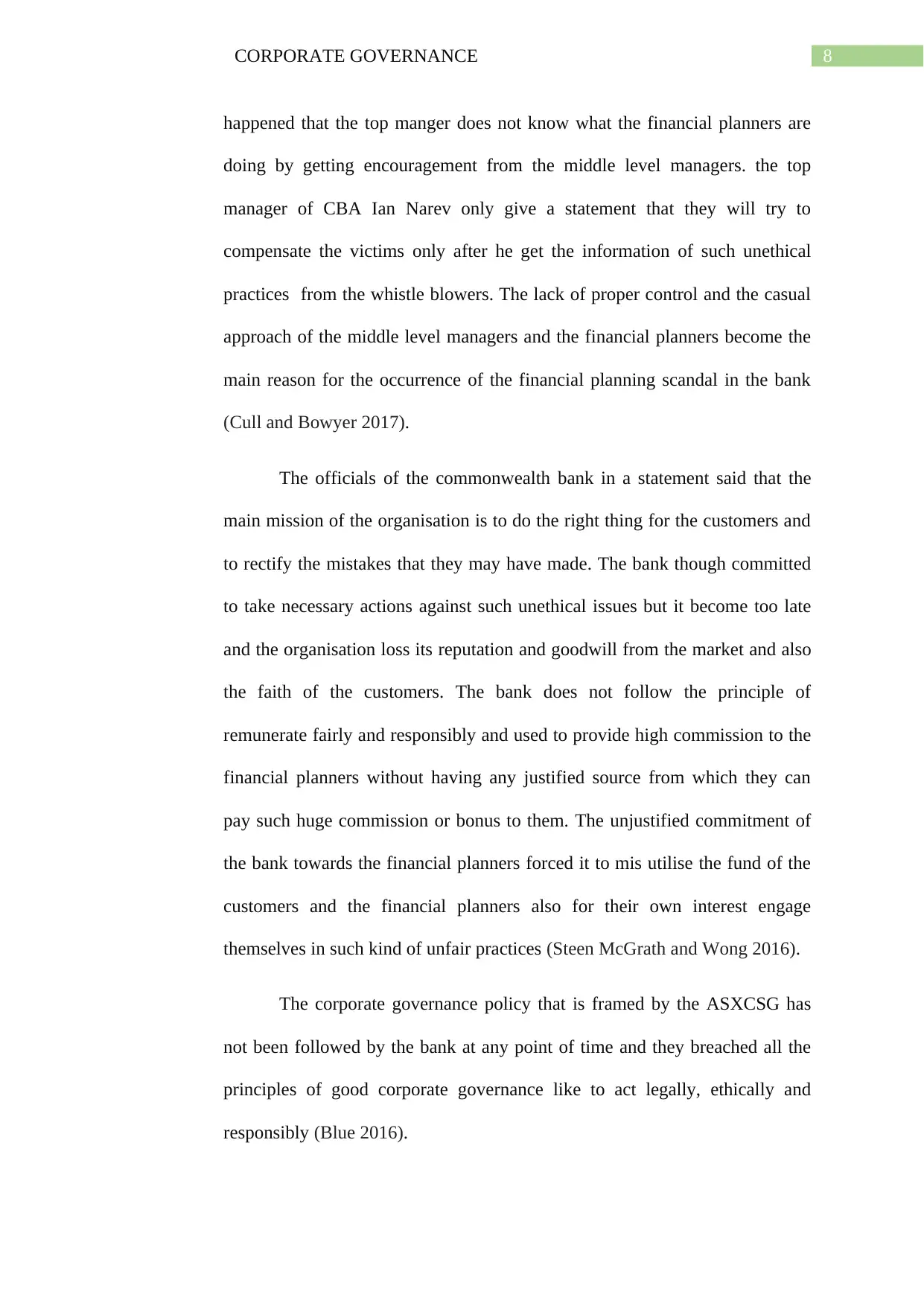
8CORPORATE GOVERNANCE
happened that the top manger does not know what the financial planners are
doing by getting encouragement from the middle level managers. the top
manager of CBA Ian Narev only give a statement that they will try to
compensate the victims only after he get the information of such unethical
practices from the whistle blowers. The lack of proper control and the casual
approach of the middle level managers and the financial planners become the
main reason for the occurrence of the financial planning scandal in the bank
(Cull and Bowyer 2017).
The officials of the commonwealth bank in a statement said that the
main mission of the organisation is to do the right thing for the customers and
to rectify the mistakes that they may have made. The bank though committed
to take necessary actions against such unethical issues but it become too late
and the organisation loss its reputation and goodwill from the market and also
the faith of the customers. The bank does not follow the principle of
remunerate fairly and responsibly and used to provide high commission to the
financial planners without having any justified source from which they can
pay such huge commission or bonus to them. The unjustified commitment of
the bank towards the financial planners forced it to mis utilise the fund of the
customers and the financial planners also for their own interest engage
themselves in such kind of unfair practices (Steen McGrath and Wong 2016).
The corporate governance policy that is framed by the ASXCSG has
not been followed by the bank at any point of time and they breached all the
principles of good corporate governance like to act legally, ethically and
responsibly (Blue 2016).
happened that the top manger does not know what the financial planners are
doing by getting encouragement from the middle level managers. the top
manager of CBA Ian Narev only give a statement that they will try to
compensate the victims only after he get the information of such unethical
practices from the whistle blowers. The lack of proper control and the casual
approach of the middle level managers and the financial planners become the
main reason for the occurrence of the financial planning scandal in the bank
(Cull and Bowyer 2017).
The officials of the commonwealth bank in a statement said that the
main mission of the organisation is to do the right thing for the customers and
to rectify the mistakes that they may have made. The bank though committed
to take necessary actions against such unethical issues but it become too late
and the organisation loss its reputation and goodwill from the market and also
the faith of the customers. The bank does not follow the principle of
remunerate fairly and responsibly and used to provide high commission to the
financial planners without having any justified source from which they can
pay such huge commission or bonus to them. The unjustified commitment of
the bank towards the financial planners forced it to mis utilise the fund of the
customers and the financial planners also for their own interest engage
themselves in such kind of unfair practices (Steen McGrath and Wong 2016).
The corporate governance policy that is framed by the ASXCSG has
not been followed by the bank at any point of time and they breached all the
principles of good corporate governance like to act legally, ethically and
responsibly (Blue 2016).
⊘ This is a preview!⊘
Do you want full access?
Subscribe today to unlock all pages.

Trusted by 1+ million students worldwide
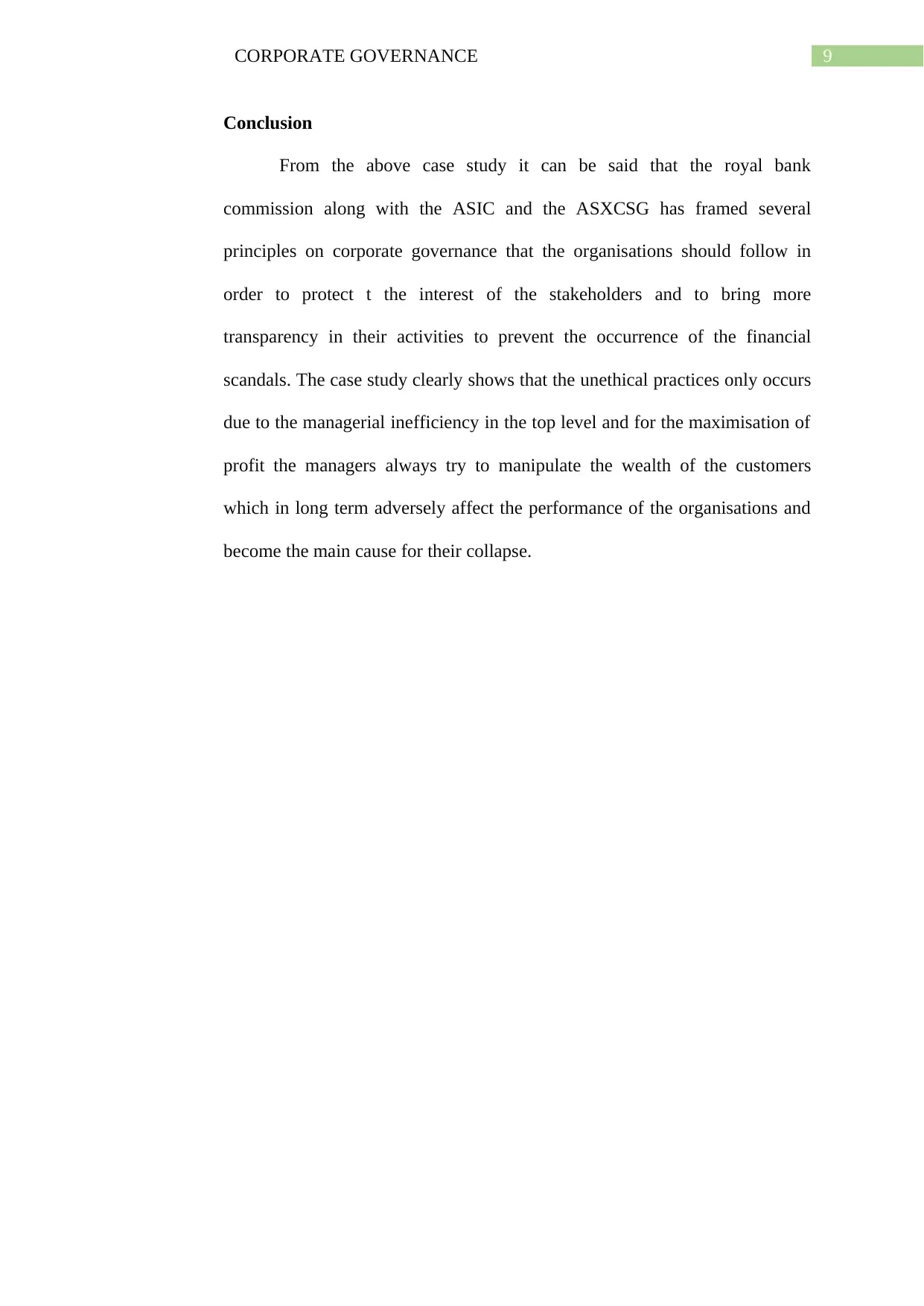
9CORPORATE GOVERNANCE
Conclusion
From the above case study it can be said that the royal bank
commission along with the ASIC and the ASXCSG has framed several
principles on corporate governance that the organisations should follow in
order to protect t the interest of the stakeholders and to bring more
transparency in their activities to prevent the occurrence of the financial
scandals. The case study clearly shows that the unethical practices only occurs
due to the managerial inefficiency in the top level and for the maximisation of
profit the managers always try to manipulate the wealth of the customers
which in long term adversely affect the performance of the organisations and
become the main cause for their collapse.
Conclusion
From the above case study it can be said that the royal bank
commission along with the ASIC and the ASXCSG has framed several
principles on corporate governance that the organisations should follow in
order to protect t the interest of the stakeholders and to bring more
transparency in their activities to prevent the occurrence of the financial
scandals. The case study clearly shows that the unethical practices only occurs
due to the managerial inefficiency in the top level and for the maximisation of
profit the managers always try to manipulate the wealth of the customers
which in long term adversely affect the performance of the organisations and
become the main cause for their collapse.
Paraphrase This Document
Need a fresh take? Get an instant paraphrase of this document with our AI Paraphraser
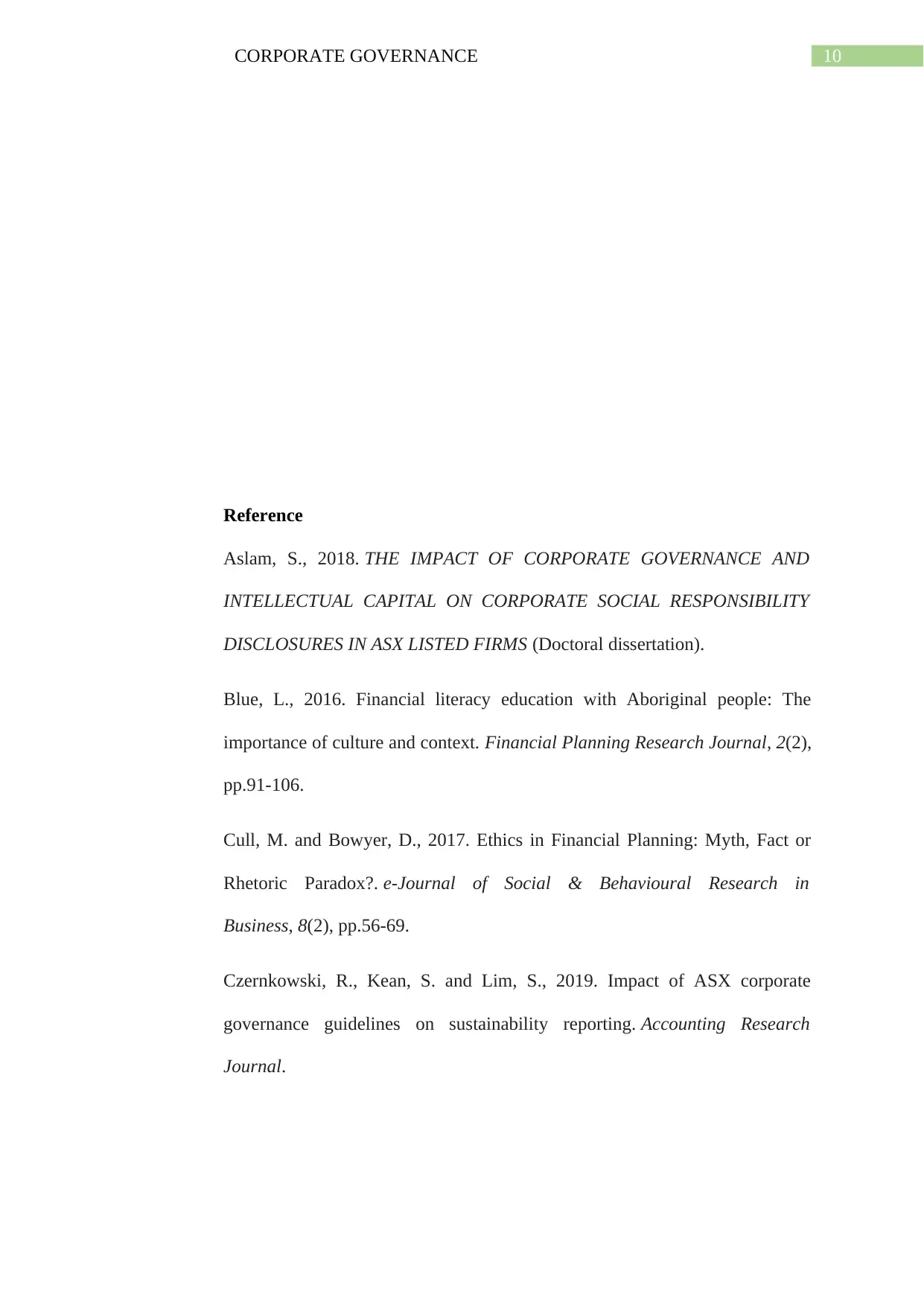
10CORPORATE GOVERNANCE
Reference
Aslam, S., 2018. THE IMPACT OF CORPORATE GOVERNANCE AND
INTELLECTUAL CAPITAL ON CORPORATE SOCIAL RESPONSIBILITY
DISCLOSURES IN ASX LISTED FIRMS (Doctoral dissertation).
Blue, L., 2016. Financial literacy education with Aboriginal people: The
importance of culture and context. Financial Planning Research Journal, 2(2),
pp.91-106.
Cull, M. and Bowyer, D., 2017. Ethics in Financial Planning: Myth, Fact or
Rhetoric Paradox?. e-Journal of Social & Behavioural Research in
Business, 8(2), pp.56-69.
Czernkowski, R., Kean, S. and Lim, S., 2019. Impact of ASX corporate
governance guidelines on sustainability reporting. Accounting Research
Journal.
Reference
Aslam, S., 2018. THE IMPACT OF CORPORATE GOVERNANCE AND
INTELLECTUAL CAPITAL ON CORPORATE SOCIAL RESPONSIBILITY
DISCLOSURES IN ASX LISTED FIRMS (Doctoral dissertation).
Blue, L., 2016. Financial literacy education with Aboriginal people: The
importance of culture and context. Financial Planning Research Journal, 2(2),
pp.91-106.
Cull, M. and Bowyer, D., 2017. Ethics in Financial Planning: Myth, Fact or
Rhetoric Paradox?. e-Journal of Social & Behavioural Research in
Business, 8(2), pp.56-69.
Czernkowski, R., Kean, S. and Lim, S., 2019. Impact of ASX corporate
governance guidelines on sustainability reporting. Accounting Research
Journal.
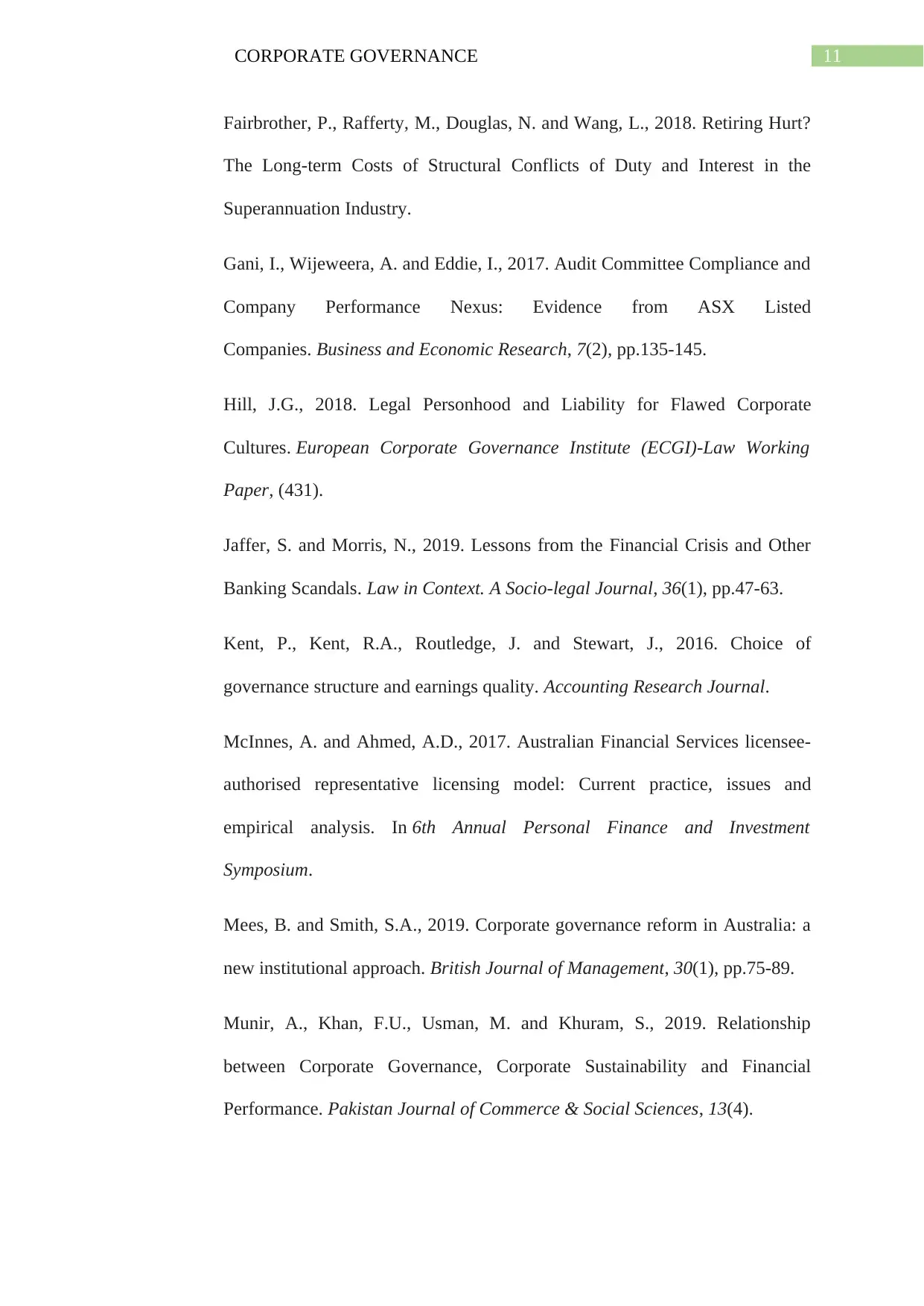
11CORPORATE GOVERNANCE
Fairbrother, P., Rafferty, M., Douglas, N. and Wang, L., 2018. Retiring Hurt?
The Long-term Costs of Structural Conflicts of Duty and Interest in the
Superannuation Industry.
Gani, I., Wijeweera, A. and Eddie, I., 2017. Audit Committee Compliance and
Company Performance Nexus: Evidence from ASX Listed
Companies. Business and Economic Research, 7(2), pp.135-145.
Hill, J.G., 2018. Legal Personhood and Liability for Flawed Corporate
Cultures. European Corporate Governance Institute (ECGI)-Law Working
Paper, (431).
Jaffer, S. and Morris, N., 2019. Lessons from the Financial Crisis and Other
Banking Scandals. Law in Context. A Socio-legal Journal, 36(1), pp.47-63.
Kent, P., Kent, R.A., Routledge, J. and Stewart, J., 2016. Choice of
governance structure and earnings quality. Accounting Research Journal.
McInnes, A. and Ahmed, A.D., 2017. Australian Financial Services licensee-
authorised representative licensing model: Current practice, issues and
empirical analysis. In 6th Annual Personal Finance and Investment
Symposium.
Mees, B. and Smith, S.A., 2019. Corporate governance reform in Australia: a
new institutional approach. British Journal of Management, 30(1), pp.75-89.
Munir, A., Khan, F.U., Usman, M. and Khuram, S., 2019. Relationship
between Corporate Governance, Corporate Sustainability and Financial
Performance. Pakistan Journal of Commerce & Social Sciences, 13(4).
Fairbrother, P., Rafferty, M., Douglas, N. and Wang, L., 2018. Retiring Hurt?
The Long-term Costs of Structural Conflicts of Duty and Interest in the
Superannuation Industry.
Gani, I., Wijeweera, A. and Eddie, I., 2017. Audit Committee Compliance and
Company Performance Nexus: Evidence from ASX Listed
Companies. Business and Economic Research, 7(2), pp.135-145.
Hill, J.G., 2018. Legal Personhood and Liability for Flawed Corporate
Cultures. European Corporate Governance Institute (ECGI)-Law Working
Paper, (431).
Jaffer, S. and Morris, N., 2019. Lessons from the Financial Crisis and Other
Banking Scandals. Law in Context. A Socio-legal Journal, 36(1), pp.47-63.
Kent, P., Kent, R.A., Routledge, J. and Stewart, J., 2016. Choice of
governance structure and earnings quality. Accounting Research Journal.
McInnes, A. and Ahmed, A.D., 2017. Australian Financial Services licensee-
authorised representative licensing model: Current practice, issues and
empirical analysis. In 6th Annual Personal Finance and Investment
Symposium.
Mees, B. and Smith, S.A., 2019. Corporate governance reform in Australia: a
new institutional approach. British Journal of Management, 30(1), pp.75-89.
Munir, A., Khan, F.U., Usman, M. and Khuram, S., 2019. Relationship
between Corporate Governance, Corporate Sustainability and Financial
Performance. Pakistan Journal of Commerce & Social Sciences, 13(4).
⊘ This is a preview!⊘
Do you want full access?
Subscribe today to unlock all pages.

Trusted by 1+ million students worldwide
1 out of 13
Related Documents
Your All-in-One AI-Powered Toolkit for Academic Success.
+13062052269
info@desklib.com
Available 24*7 on WhatsApp / Email
![[object Object]](/_next/static/media/star-bottom.7253800d.svg)
Unlock your academic potential
Copyright © 2020–2025 A2Z Services. All Rights Reserved. Developed and managed by ZUCOL.




